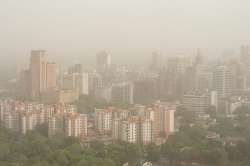Delhi air quality turns 'severe': Private vehicles may be pulled off roads; major constructions in Ghaziabad to stop
Our graded action response plan will be implemented from November 1, said Bhure Lal, Chairman, Environment Pollution Control Authority.

In view of rising air pollution in the national capital, Environment Pollution Control Authority on Tuesday said private cars will be stopped from plying in the capital if air pollution continues to worsen.
"Let us hope the air pollution situation in Delhi doesn't deteriorate or else we will have to stop plying of private vehicles. Only public transport will be used," Bhure Lal, Chairman, Environment Pollution Control Authority, was quoted as saying.
Our graded action response plan will be implemented from November 1, Lal said.
With stubble burning intensifying in neighbouring states, the air quality in Delhi turned ‘severe’ for the first time this season on Tuesday, authorities said. According to the officials of Central Pollution Control Board, the overall Air Quality Index (AQI) at 3 pm was 401, falling in the 'severe' category, the highest this season.
The volume of particulate matters was well above "severe" levels by 9 a.m.
The air quality is set to deteriorate further from November 1, and the Diwali this year is likely to be more polluted, the CPCB said.
Meanwhile, Ghaziabad DM Ritu Maheshwari advised the NHAI to halt major construction activities on Delhi MEERUT expressway within Ghaziabad till November 10.
An AQI between 0 and 50 is considered 'good', 51 and 100 'satisfactory', 101 and 200 'moderate', 201 and 300 'poor', 301 and 400 'very poor', and 401 and 500 'severe'.
The Centre-run System of Air Quality Forecasting and Research (SAFAR) attributed the spike to "heavy stubble burning in the last 24 hours and calm winds".
The city witnessed a thick layer of haze on Tuesday morning, which affected visibility. Experts warned that episodes of smog will begin in a couple of days.
Regional factors like stubble burning led to nearly 28 per cent of pollution by PM2.5 (presence of particles in the air with a diameter of less than 2.5 micrometres) on Tuesday, said SAFAR officials.
Large number of biomass fire spots was also spotted by the Indian Institute of Tropical Meteorology (IITM) through satellite imageries in neighbouring states of Delhi.
Commenting on the situation, IMD Head KJ Ramesh said, "It is haze since the Ozone is at a good level.”
On Tuesday, almost all places in the NCR saw a sharp rise in the major pollutants - PM2.5 and PM10 - particles in the air with diameters less than 2.5mm and 10mm, respectively.
Across 35 active pollution monitored area in Delhi, the average concentration of PM2.5 and PM10 was 273 microgrammes per cubic meters and 487 units by 3 p.m.
The same PM2.5 and PM10 concentration across 48 monitored area of National Capital Region (NCR) was 263 units and 470 units.
Air quality is considered "severe" when either AQI is between 401 and 500 or PM2.5 is between 250 and 300 or the PM10 levels are between 430 and 500, according to CPCB.
The safe limit for PM2.5 is 60 units as per national standards and 25 units according to the international standards.
For PM10, up to 100 units is safe from national standards and 50 units international standards.
At 3 p.m., the AQI was 425 at Gurugram, 412 in Faridabad, 410 at Sector-125 Noida, and 449 at Ghaziabad, all considered severe. At Greater Noida, AQI was 395, on the verge of being severe.
The World Health organisation also came out with an analysis of 2016 data according to which over one lakh children under the age of five died after exposure to toxic air.
The study noted that about 98 per cent of children in the same age group in low and middle-income countries, include nations like India, were exposed to air pollution.
In the report, titled 'Air Pollution and Child Health: Prescribing Clean Air', deaths of about 600,000 children under 15 years of age in 2016 were attributed to the joint effects of ambient and household air pollution.
India reported 60,987 deaths of children under the age of five due to exposure to toxic air in 2016, of which 32,889 were girls and 28,097 boys.
Ban on old vehicles in Delhi
In view of alarming deterioration in Delhi's air quality, the Supreme Court on Monday prohibited the plying of 15-year-old petrol and 10-year-old diesel vehicles in the national capital region.
The apex court made it clear that such vehicles would be impounded if found on the roads in Delhi-NCR.
Terming as "very critical" and "horrible" the prevailing pollution situation in Delhi-NCR, the apex court directed that a list of 15-year-old petrol and 10-year-old diesel vehicles be published on the website of the Central Pollution Control Board (CPCB) and transport departments of the NCR area.

